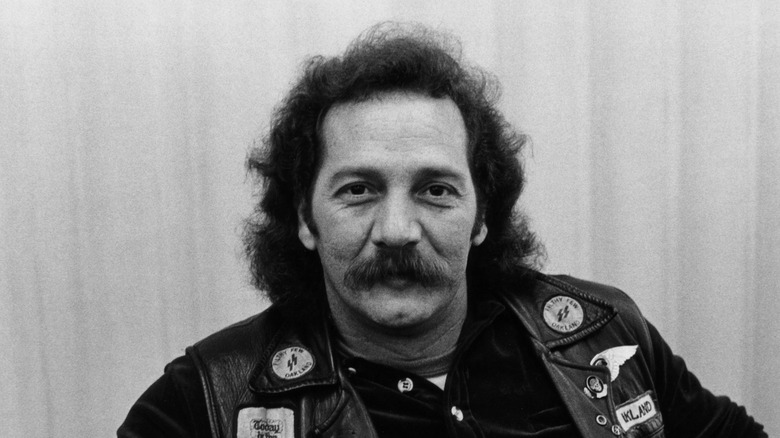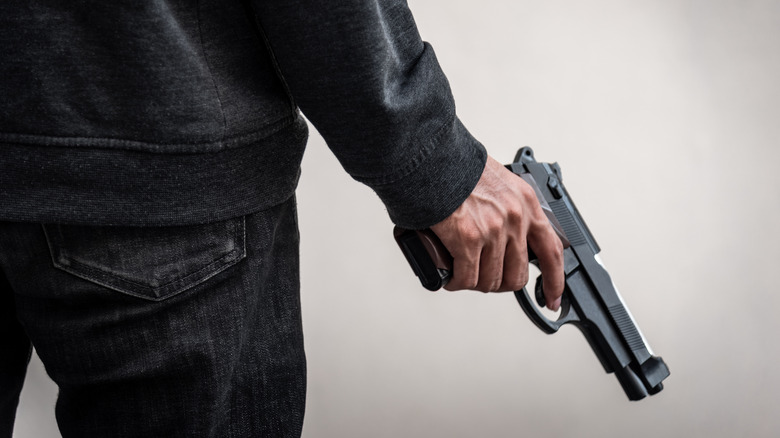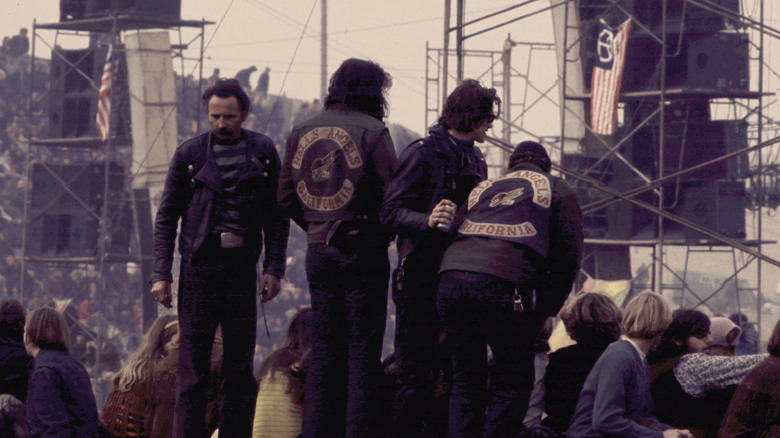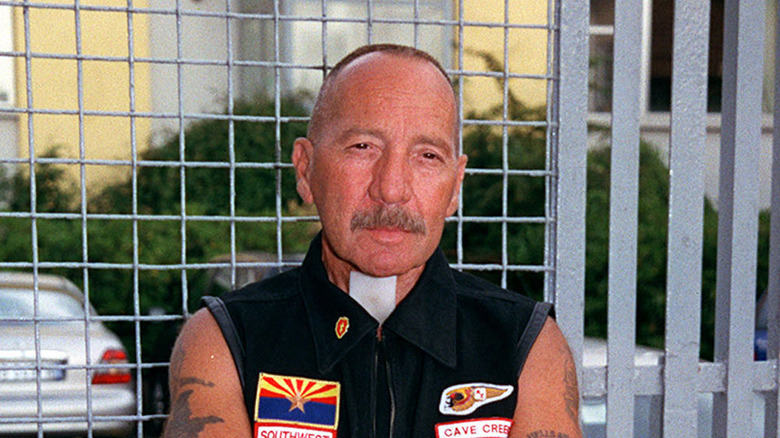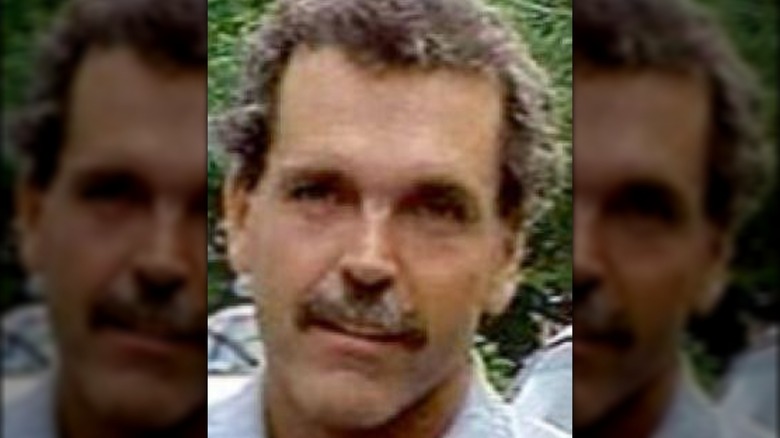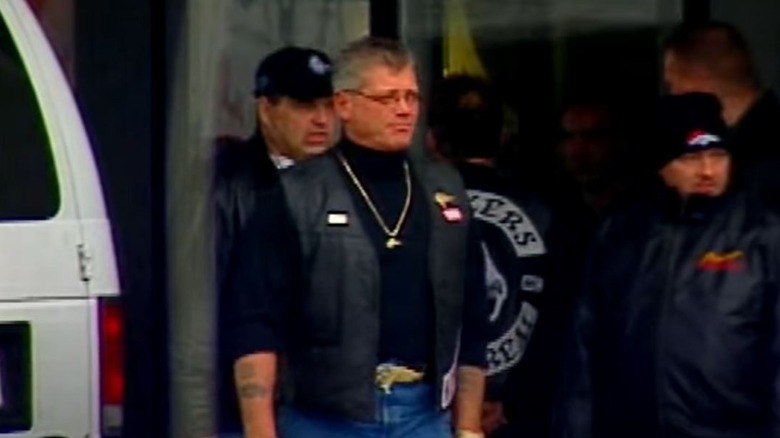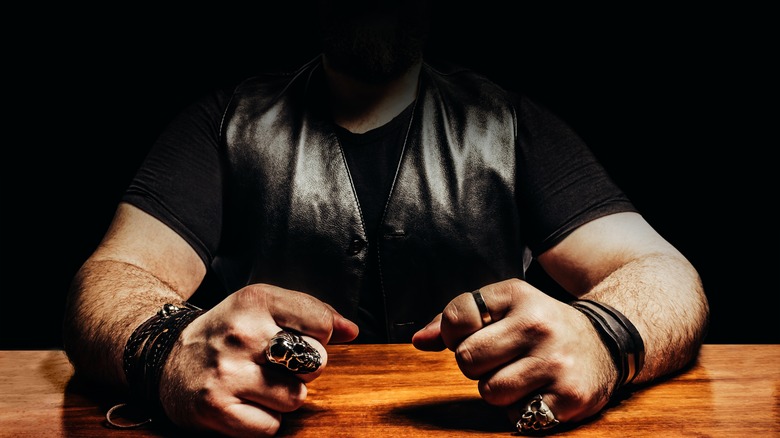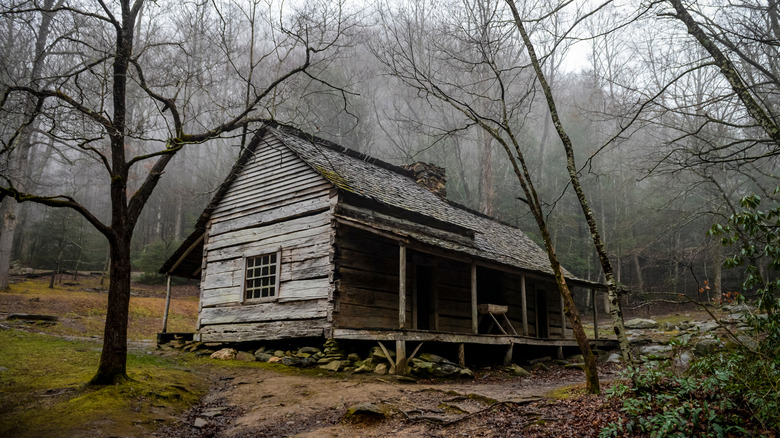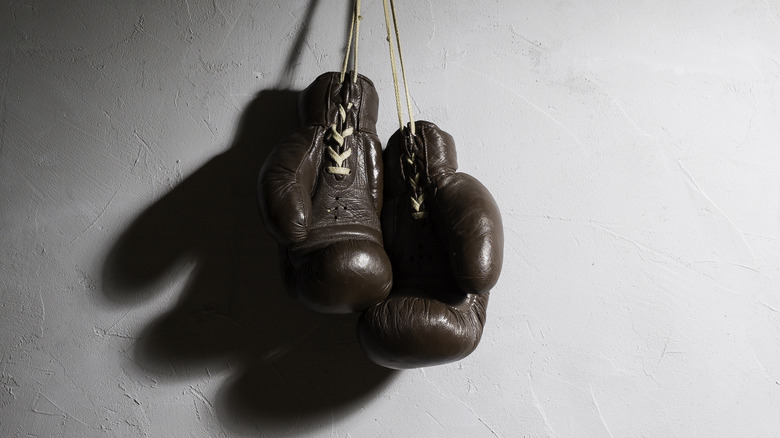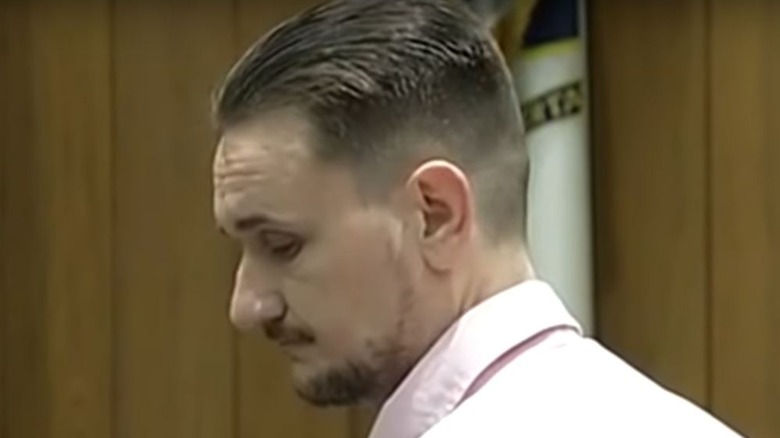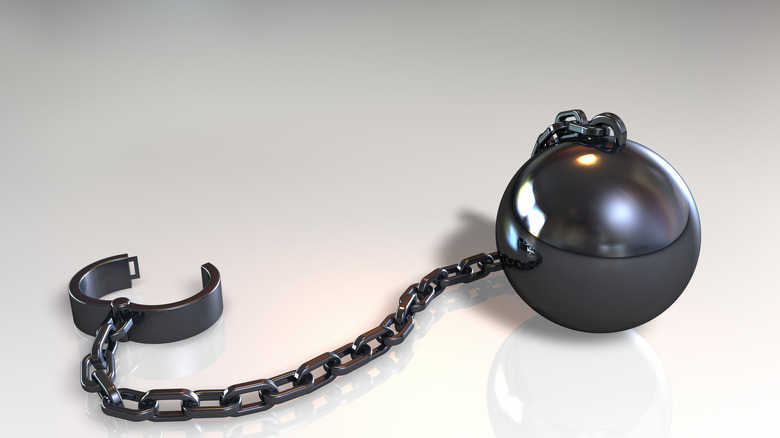The Most Dangerous Members Of The Hells Angels
Hells Angels Motorcycle Club was founded in 1948, and thanks to the cultural exposure it received in the 1960s, it soon became famous ... or rather, infamous. Thanks to the unconventional lifestyle, scary look, and nasty reputation of its members, the Hells Angels was a perfect bogeyman for the average citizen. However, that doesn't mean it was a harmless group unfairly saddled with infamy. On the contrary, the club has plenty of members who have committed terrifying crimes, and who more than live up to its notoriety.
Hells Angels has been presented in an unsavory light by sources that range from the justice system to gonzo legend Hunter S. Thompson, whose first book, "Hells Angels: The Strange and Terrible Saga of the Outlaw Motorcycle Gangs," offered unprecedented exposure for the club — though Thompson also exposed some of the Angels' nastier habits, such as the group beating the writer received. Of course, due to its members' historical tendency to partake in criminal activities, the club doesn't necessarily need outside help to uphold its reputation. Let's take a look at some of the scariest people who have worn the Hells Angels colors over the years, and precisely why they're so dangerous.
The following article contains descriptions of suicide, sexual abuse, and child abuse.
Yves Trudeau
Several members of the Hells Angels Motorcycle Club have killed people, but Yves "Apache" Trudeau is a particularly notorious case. He was a professional assassin who claimed to have killed as many as 43 people — although the number is inflated since he cut a deal with the authorities and later stated he was merely an accomplice in half of the cases.
Trudeau was already a biker and a murderer when he joined the Hells Angels in 1977, and as crime writer James Dubro told Vice, he quickly developed a scary reputation. "He had absolutely no conscience, no respect for human life at all," Dubro said. Trudeau's methods of murder ranged from knives to bombs. As his infamy grew, he started killing people for numerous different criminal organizations, even murdering his own kind when the situation required. The increasing tensions between various criminal groups and Trudeau's hitman role eventually painted a target on his back. While he narrowly avoided becoming one of the victims of a brutal mass murder known as the Lennoxville Massacre, he was expelled from the Hells Angels. By 1985, he had a bounty on his head.
He survived by switching sides. Trudeau became a police informant and pleaded guilty to 43 manslaughters. He was paroled in 1994 and started life under a new identity. However, in 2004, he was sent back to prison for sexually assaulting a minor. During this time, he became sick with cancer and died shortly after his release in 2008.
Alan Passaro
Alan Passaro might not have the longest criminal record among the Hells Angels. However, the fact that his name is forever associated with one of the most infamous incidents in the organization's history more than warrants his inclusion on a list of the most dangerous Hells Angels.
The Rolling Stones have a long career that's full of highs and lows, but when it comes to their darkest hour, many would likely name the tragedy at their Altamont concert on December 6, 1969. The swiftly organized free concert at the Altamont Speedway has become known as the infamous antithesis of Woodstock. It drew a crowd of 300,000 to a distant race track venue ... and used Hells Angels as security.
This wasn't an ideal decision. The bikers' brand of maintaining order featured multiple violent incidents, the most notorious being the fatal stabbing of 18-year-old Meredith Hunter. In what just might be the most highly-publicized killing in Hells Angels' storied history, Passaro leaped down from the stage and stabbed the young man to death during the Rolling Stones' performance. The Hells Angel was eventually acquitted because Hunter had drawn a gun and the case was considered self-defense, but a nameless eyewitness told Rolling Stone in 1970 that the bikers specifically attacked Hunter before they even knew he had a gun. "So they're chasing through the crowd," the eyewitness said. "And they hitting him and one Hells Angel pulled out a knife and stabbed him in the back."
Sonny Barger
Sonny Barger's rap sheet is lengthy, but as the longtime face and arguably the single most prominent member of the Hells Angels, his true danger was in his visibility and influence. He first rose to prominence as the president and co-founder of the club's Oakland, California, chapter when Hunter S. Thompson depicted their lifestyle in the 1966 book "Hell's Angels: The Strange and Terrible Saga of the Outlaw Motorcycle Gangs." After that, Barger acted as the organization's leader and public face for decades.
Barger was a key person in the Hells Angels' clashes with anti-war protesters in 1965, taking a pro-war side and even trying to contact President Lyndon B. Johnson to offer the organization's services in the war effort. He also acted as a public spokesman in many Hells Angels-related scandals and incidents, gaining enough personal notoriety to work in Hollywood, write books, and even market a line of Barger-branded products.
Despite his comparatively public status, Barger's hands weren't clean when it came to criminal activities. He was arrested numerous times for various possession and violence-themed crimes, charged with a list of crimes that included murder and kidnapping, and did time for firearm and heroin possession and aggravated assault. He also had a hand in creating some of the most famous outlaw biker visuals, from the infamous one-percenter patch that signified a person's status as an outlaw to the apostrophe-free spelling of Hells Angels. Barger died in 2022 at age 83.
David Carroll
When a man's nickname is "Wolf," and Interpol suspects that he's been involved in 13 murders and two attempted murders, it's pretty clear that the person in question is highly dangerous. This is precisely the case with David Carroll, a Canadian Hells Angel who has been on the run since 2001 and continues to elude the authorities.
Carroll was a member of Quebec's notorious and violent Nomads chapter of the motorcycle club, but managed to evade capture when the police effectively ended the Nomads' reign of terror in a large arrest operation in 2001. Carroll remains the sole Nomad who's still on the loose, and thanks to the Hells Angels' vast connections and his fluency in both English and French, he could be anywhere the organization has a presence. Reported Wolf sightings have been made in countries that range from Brazil to South Africa and Australia, but the man has never been found. What's more, if people who know him are aware of his whereabouts, they're staying quiet as well. When fellow Angel Leslie Greenwood — who considers Carroll something of an uncle since the older man used to be in a relationship with his aunt – was standing trial for two murders in 2015, he specifically denied having any information about Carroll beyond the fact that he's on the run (via The Montreal Gazette).
Carroll would be in his 70s if he's still alive, so it's starting to seem unlikely that he'll ever be caught.
Maurice Boucher
One of the several Canadian Hells Angels on this list and arguably the most powerful, Maurice "Mom" Boucher became a fully-fledged Hells Angel in 1987 and started making moves in Quebec's criminal underbelly. He ultimately formed his own Hells Angels Nomads chapter that was a powerful player in the war Boucher waged against the region's other outlaw biker groups as part of his quest to become the sole kingpin of the area's drug trade.
The authorities eventually pinpointed Boucher as a prominent Hells Angels leader and a key player in the mayhem, at which point he started applying his murderous tactics to them, as well. He ordered the deaths of two prison guards and the attempted murder of a third one, and the total death toll of the biker wars was over 165. Not every victim was a biker, either — thanks to the factions' use of explosive methods like car bombs, there were also innocent victims.
It took the authorities quite a while to get Boucher behind bars. His first trial ended in an acquittal in 1998, but a second trial was more successful — and in 2002, he was handed a life sentence. He died of throat cancer in 2022 at age 69, three years before he would have been up for parole ... which, in all fairness, might not have been on the cards in any case, considering that he attempted to arrange an assassination of a fellow criminal during his time in prison.
James Brandes
James "Jim-Jim" Brandes is a curious case in the annals of the Hells Angels Motorcycle Club. The authorities considered him one of the top Hells Angels power players of his era, and he was close with the club's top dog, Sonny Barger. He was arrested multiple times in the 1960s and 1970s for crimes that ranged from forgery to conspiracy to commit murder, and even briefly escaped from prison in 1969. The police were pretty sure that he was involved in four or five murders. When he visited the Australian chapter in 1978, he had a reputation as a hitman and was promptly sent back home. Two different law enforcement figures who clashed with him were injured by a car bomb.
Despite all this, Brandes kept escaping serious convictions for quite a while. However, his luck didn't last forever. He was linked with a long-running investigation of a 1977 execution murder of Margo Compton, her two children, and a man called Gary Seslar. In 1994, the first trial connected to the case was against a Hells Angels hopeful called Robert McClure, but a criminal called Victor Carrafa testified that he had heard Brandes admitting that he was one of the murderers. Brandes died by suicide in prison between the first and the second trial, and McClure was eventually found guilty despite insisting that he had been framed.
Benjamin Silva
The scariest kind of criminal is unpredictable, with no reason or rhyme to their actions. Hells Angel Benjamin Silva fits this horrible bill. In January 1981, in Lassen County, California, he and two other men — Norman Thomas and Joseph Shelton — started following a young couple they encountered at a gas station on a whim, and convinced them to stop their car by impersonating a police car with a red dashboard light. What followed is something straight out of a horror movie.
The three perpetrators hijacked the car and drove the kidnapped youngsters into a secluded cabin, where they proceeded to brutally torture them in different ways. The male victim was chained to a tree and left exposed to the elements while the attackers sexually assaulted the female victim numerous times. Eventually, Silva and Shelton shot the male victim to death with a machine gun, and the Hells Angel had Shelton dismember the body. After enduring the torture for three days, the female victim was shot to death.
Silva was placed on death row for his part in the crimes in 1982, but the Lassen County district attorney withheld important information while handling the case, which caused the death sentence to be overturned. The Hells Angel eventually received a new sentence of 25 years to life.
Phil Boudreault
Phil Boudreault's criminal record pales in comparison with some other folks on this list, but he has a pretty good chance of being one of the most physically dangerous people in Hells Angels. After all, he's not just the vice president of a Nomads chapter — he's also a former Olympic-level boxer who competed at the 1996 Atlanta Summer Olympics.
Boudreault has clashed with the law numerous times, the worst of them being exactly the kind of thing one might expect of a top-level boxer who's also a Hells Angel: A 2004 assault case where he beat up two people, breaking one victim's jaw in three places. For this, he spent two years in prison and was placed on a 10-year, high-supervision, long-term offender list, the terms of which he violated with failed drug tests and associating with the criminal element.
Apart from breaking the law himself, Boudreault has also been on the receiving end of violence. In 2016, he was riding his motorcycle when he was shot twice in a drive-by hit, but survived the attempt on his life.
Adam Lee Hall
Adam Lee Hall isn't just a prominent Hells Angel in Peru, Massachusetts — he's also a convicted triple murderer. Along with two accomplices, Caius Veiovis and David Chalue, Hall was sentenced to life without the possibility of parole in 2014 for a gruesome case that involved the shooting and dismembering of David Glasser and two of his friends. Hall and Glasser had a history of animosity that involved the latter intending to testify against the former in an assault case, and culminated in the triple murder in 2011. When the victims' bodies were found in a ditch, the authorities immediately charged Hall, Veiovis, and Chalue.
The case proved to be a difficult one. Hall already had a history of unconventional legal strategies, having unsuccessfully attempted to become an FBI informant in a previous case. He ended up wrecking his relationship with his defense attorney by discussing the lawyer's tactics with the police, and even after the conviction, has attempted numerous ways to get a retrial. His sentence has indeed become shorter since 2014: Hall was originally also convicted of kidnapping Glasser in 2010, but this was ultimately overturned in 2020. This has left him with four consecutive life sentences instead of the original five.
David Richards
In 1984, British Hells Angel David Richards and his girlfriend killed a 16-year-old boy, Michael Groves. The murder was a particularly gruesome one that involved a hammer, a wrench, and a knife. Afterward, Richards wrote the motorcycle club's name on the wall with the victim's blood. In 2005, Richards walked out of Sudbury Open Prison and resumed his life like nothing had happened, interacting with his parents and taking a trip to Ireland without any issue. The police did notice that he'd escaped and marked it on their system but didn't do much to actually find him. The situation lasted nine years.
The truly unnerving thing about the case is how easily Richards slipped through the cracks. Granted, Richards was a far older man now, but he was still a known Hells Angel who had committed a particularly brutal murder, so it seemed strange that he could escape for such a long time, let alone so easily. What's more, during his years in freedom, he was able to claim benefits and use his passport without any issues. At one point, he complained to the police about misbehaving kids.
Although Richards was eventually caught and returned to jail, Groves' family wasn't particularly happy about the situation. "This man was living a normal life having brutally killed my brother and it seems the police did nothing to recapture him," the victim's sister, Louise Bull, told The Standard. "Michael was a lovely boy and he was just starting out in life."
If you or anyone you know may be the victim of sexual assault or child abuse, or are struggling or in crisis, contact the relevant resources below:
-
The Rape, Abuse & Incest National Network website or contact RAINN's National Helpline at 1-800-656-HOPE (4673)
-
The Childhelp National Child Abuse Hotline at 1-800-4-A-Child (1-800-422-4453) or contact their live chat services
-
Call or text 988 or chat 988lifeline.org
